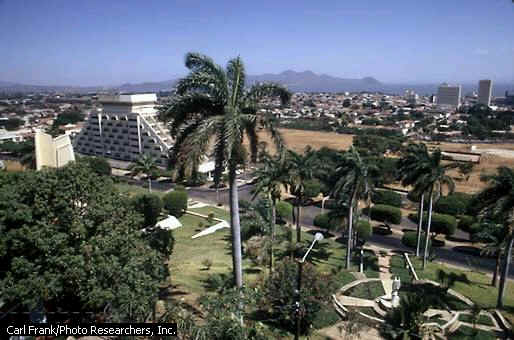Sweet Managua

20 August 2000, Managua, Nicaragua
Wending my way down the Masaya highway on the way to work every morning, I get caught up in a brutal swirl of vehicles desperately struggling to advance through the narrow concrete streets. The bent up buses belch hydrocarbons in black spumes and tempers ignite as we do laps around the new traffic circles, while, around the perimeter, bland concrete structures and government propaganda on wooden billboards emphasize how aesthetically unpleasing Managua is to the eye. There's very little that's beautiful in Managua. And faced with the grimness of this tropical city in the beginning of the 21st century, it's hard not to think of Managua as it was in prehistoric times.
In those days it was home to the Chorutega people who, having traveled
south from what's now Mexico, settled at the forested shore of Lake
Xolotlan to fish and hunt under the shadow of twin volcanoes that
greet me in my morning commute even today. In those days the lake was
clean and wholesome and the tropical forest teemed with wild birds and
mammals. That Managua is more enticing to the imagination than the
decrepit concrete sprawl of faceless neighborhoods that makes up
Nicaragua's present-day capital, in which squatters inhabit the ruined
shells of the buildings felled in the earthquake of `72, where the
waters of the very same Xolotlan are leaden and too contaminated to
support aquatic life much less drink, where children hawking
newspapers and cashews patrol the intersections by day, and where at
night running the red traffic lights is preferable to running the risk
of being robbed while waiting at them. Managua is especially ugly
considering the stark natural beauty of the countryside that surrounds
it, and so its charm - the people that inhabit it- stands out even
more clearly.

Nicaraguans are a resilient people, and Managuans even more so. And they're used to rebuilding: after the earthquake of '31 and the fire that followed it five years later, after the devastating earthquake of '72 that leveled over 600 city blocks and killed ten thousand, after the revolution and the ten years of civil war that followed, and now after Hurricane Mitch. Deep in the concrete entrails of this city, the prehistoric footprints of Acahualinca are testimony to disasters that occurred long before this century, when people running towards the lake's edge fleeing a volcanic eruption to the south left their footprints preserved in the volcanic mud. And the network of seismic faults on top of which Managua sits speak of disasters yet to be. Managua, ever rebuilding, is in flux. And it's enjoyable to be a part of that rebuilding, even if that means being forced to live in what I'm sure is the ugliest city in the northern hemisphere.
The zeal with which Nicaraguans live life is striking to me, as is the intensity with which they approach their days, even the aggressive way they maneuver around those traffic circles. I think the cycle of destruction and rebirth that's so very much a part of the rhythm of this poor tropical country has imbued the Nicaraguans with a palpable sense of the present, and I have much to learn from them. The lesson, and I consider it as I look over the city from the hilltops south of Managua, is perhaps to be found in the shadows of volcanic Mt. Momotombo and the turquoise lagoon of Xiloa: that the earth is in motion and we build upon its shaky surface, that expansion and contraction are natural and unavoidable and perhaps even necessary, and that one day long after I finish my days with the "Hurricane Mitch Reconstruction Program," yet another natural disaster will bring Managua to its knees. And the Managuans, at the shore of Lake Xolotlan, knew it all along and live their days to the fullest.
All well under the mango tree,
Randy
Trackbacks
The author does not allow comments to this entry

Comments
Display comments as Linear | Threaded